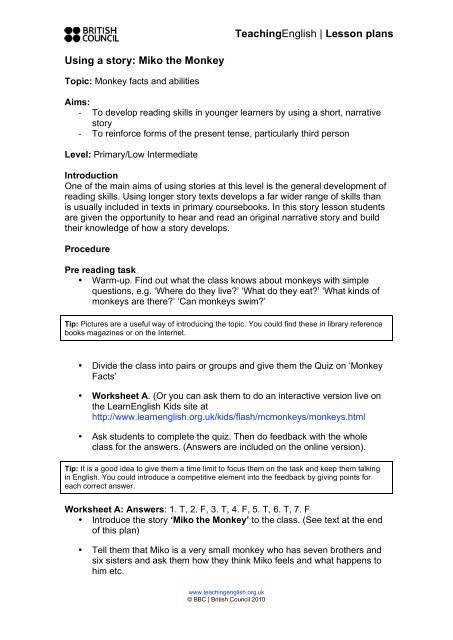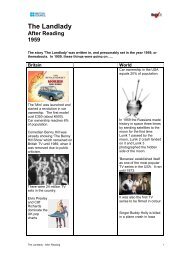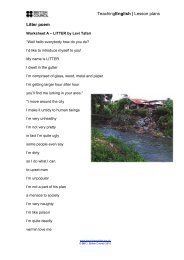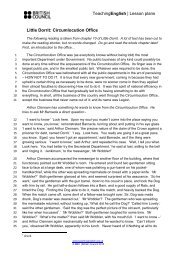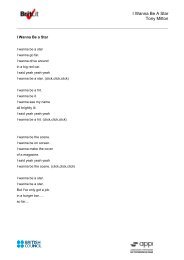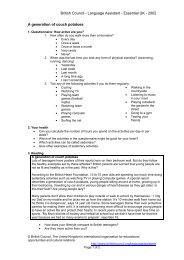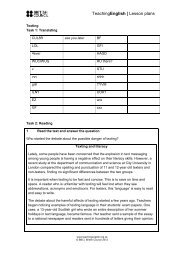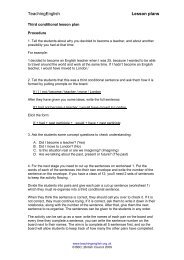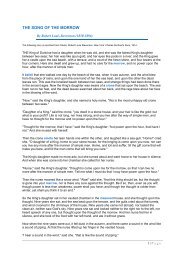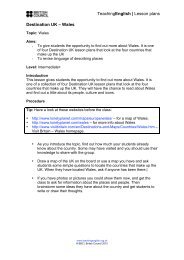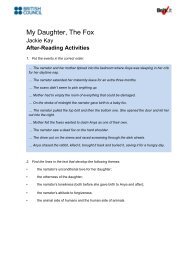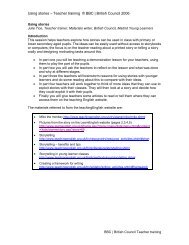TeachingEnglish | Lesson plans Using a story: Miko the Monkey
TeachingEnglish | Lesson plans Using a story: Miko the Monkey
TeachingEnglish | Lesson plans Using a story: Miko the Monkey
Create successful ePaper yourself
Turn your PDF publications into a flip-book with our unique Google optimized e-Paper software.
<strong>Using</strong> a <strong>story</strong>: <strong>Miko</strong> <strong>the</strong> <strong>Monkey</strong><br />
Topic: <strong>Monkey</strong> facts and abilities<br />
www.teachingenglish.org.uk<br />
© BBC | British Council 2010<br />
<strong>TeachingEnglish</strong> | <strong>Lesson</strong> <strong>plans</strong><br />
Aims:<br />
- To develop reading skills in younger learners by using a short, narrative<br />
<strong>story</strong><br />
- To reinforce forms of <strong>the</strong> present tense, particularly third person<br />
Level: Primary/Low Intermediate<br />
Introduction<br />
One of <strong>the</strong> main aims of using stories at this level is <strong>the</strong> general development of<br />
reading skills. <strong>Using</strong> longer <strong>story</strong> texts develops a far wider range of skills than<br />
is usually included in texts in primary coursebooks. In this <strong>story</strong> lesson students<br />
are given <strong>the</strong> opportunity to hear and read an original narrative <strong>story</strong> and build<br />
<strong>the</strong>ir knowledge of how a <strong>story</strong> develops.<br />
Procedure<br />
Pre reading task<br />
• Warm-up. Find out what <strong>the</strong> class knows about monkeys with simple<br />
questions, e.g. ‘Where do <strong>the</strong>y live?’ ‘What do <strong>the</strong>y eat?’ ‘What kinds of<br />
monkeys are <strong>the</strong>re?’ ‘Can monkeys swim?’<br />
Tip: Pictures are a useful way of introducing <strong>the</strong> topic. You could find <strong>the</strong>se in library reference<br />
books magazines or on <strong>the</strong> Internet.<br />
• Divide <strong>the</strong> class into pairs or groups and give <strong>the</strong>m <strong>the</strong> Quiz on ‘<strong>Monkey</strong><br />
Facts’<br />
• Worksheet A. (Or you can ask <strong>the</strong>m to do an interactive version live on<br />
<strong>the</strong> LearnEnglish Kids site at<br />
http://www.learnenglish.org.uk/kids/flash/mcmonkeys/monkeys.html<br />
• Ask students to complete <strong>the</strong> quiz. Then do feedback with <strong>the</strong> whole<br />
class for <strong>the</strong> answers. (Answers are included on <strong>the</strong> online version).<br />
Tip: It is a good idea to give <strong>the</strong>m a time limit to focus <strong>the</strong>m on <strong>the</strong> task and keep <strong>the</strong>m talking<br />
in English. You could introduce a competitive element into <strong>the</strong> feedback by giving points for<br />
each correct answer.<br />
Worksheet A: Answers: 1. T, 2. F, 3. T, 4. F, 5. T, 6. T, 7. F<br />
• Introduce <strong>the</strong> <strong>story</strong> ‘<strong>Miko</strong> <strong>the</strong> <strong>Monkey</strong>’ to <strong>the</strong> class. (See text at <strong>the</strong> end<br />
of this plan)<br />
• Tell <strong>the</strong>m that <strong>Miko</strong> is a very small monkey who has seven bro<strong>the</strong>rs and<br />
six sisters and ask <strong>the</strong>m how <strong>the</strong>y think <strong>Miko</strong> feels and what happens to<br />
him etc.
www.teachingenglish.org.uk<br />
© BBC | British Council 2010<br />
<strong>TeachingEnglish</strong> | <strong>Lesson</strong> <strong>plans</strong><br />
• You could pre-teach some vocabulary with visuals/flashcards. Or use <strong>the</strong><br />
activity from Worksheet B.<br />
Worksheet A: Answers<br />
1. <strong>Monkey</strong> 2. Banana 3. Nuts 4. Rambutan 5. Storm 6. Island<br />
Tip: It is a good idea to ask students to speculate on <strong>the</strong> plot of <strong>the</strong> <strong>story</strong> before <strong>the</strong>y actually<br />
see it as this raises <strong>the</strong>ir level of motivation.<br />
Reading task:<br />
• Read <strong>the</strong> <strong>story</strong> to <strong>the</strong> class. Try to use different voices for <strong>the</strong> different<br />
characters. You can stop and explain vocabulary if necessary (e.g.<br />
‘rambutans’)<br />
• Then read <strong>the</strong> <strong>story</strong> again with <strong>the</strong> students taking parts and/or reading<br />
sections.<br />
Tip: If you have access to computers or a single computer with a data projector you can read<br />
and listen to <strong>the</strong> <strong>story</strong> directly from <strong>the</strong> LearnEnglish Kids site at:<br />
http://www.learnenglish.org.uk/kids/stories/<strong>story</strong>.asp?<strong>story</strong>=69. You could stop after “We have<br />
no food, we will die here” and ask <strong>the</strong> students to predict <strong>the</strong> rest of <strong>the</strong> <strong>story</strong>. This can make<br />
it more exciting!<br />
• Ask <strong>the</strong> students to act out <strong>the</strong> <strong>story</strong> of <strong>the</strong> main characters and events.<br />
You will probably still need to be <strong>the</strong> narrator and director.<br />
Tip: You will need to pre arrange space for this. You could also find one or two props to make it<br />
more fun.<br />
Post reading:<br />
• Get <strong>the</strong> students to look at <strong>the</strong> statements in Worksheet C and decide if<br />
<strong>the</strong>y are true or false and work through <strong>the</strong> answers with <strong>the</strong>m.<br />
Worksheet B: Answers<br />
1. T 2. F 3. T 4. F 5. F 6. T<br />
Tip: It is a good idea to have a ‘quiet period’ built in to <strong>the</strong> lesson after a very active or noisy<br />
activity.<br />
• Give out Worksheet D and get <strong>the</strong> students to work toge<strong>the</strong>r to try to<br />
complete <strong>the</strong> missing word.<br />
Worksheet D: Answers<br />
<strong>Miko</strong> is a small monkey. He lives in <strong>the</strong> forest with his bro<strong>the</strong>rs and<br />
sisters. They eat bananas, fruit and nuts. But <strong>Miko</strong> is very small. He eats<br />
nothing.<br />
One day it rains and <strong>the</strong> river goes up. The monkeys have no food.<br />
His bro<strong>the</strong>r Uko falls into <strong>the</strong> river. Then <strong>Miko</strong> jumps across <strong>the</strong> river and<br />
gets bananas for his family.<br />
Uko comes back to <strong>the</strong> family. He says <strong>Miko</strong> is a very brave monkey. <strong>Miko</strong><br />
is very happy.
www.teachingenglish.org.uk<br />
© BBC | British Council 2010<br />
<strong>TeachingEnglish</strong> | <strong>Lesson</strong> <strong>plans</strong><br />
• Give out Worksheet E and ask <strong>the</strong> students to look for words from <strong>the</strong><br />
<strong>story</strong> in <strong>the</strong> grid.<br />
Tip: You could put <strong>the</strong>m in teams to do this so that it’s more competitive.<br />
Worksheet E: Answers<br />
Follow-up activities<br />
• You could ask more able students to write a simple monkey or animal<br />
<strong>story</strong> of <strong>the</strong>ir own.
www.teachingenglish.org.uk<br />
© BBC | British Council 2010<br />
<strong>TeachingEnglish</strong> | <strong>Lesson</strong> <strong>plans</strong><br />
Story text<br />
<strong>Miko</strong> <strong>the</strong> <strong>Monkey</strong><br />
<strong>Miko</strong> <strong>the</strong> monkey lives in <strong>the</strong> forest. He has a very big family. He lives with his seven bro<strong>the</strong>rs<br />
and six sisters, his mum and dad, his grandmo<strong>the</strong>r and grandfa<strong>the</strong>r, and his three aunts and<br />
four uncles. What a big family!<br />
But <strong>Miko</strong> is very unhappy. He is <strong>the</strong> smallest and youngest monkey in <strong>the</strong> family. His bro<strong>the</strong>rs<br />
and sisters laugh at him because he is so small. They swing around in <strong>the</strong> trees and <strong>Miko</strong> can’t<br />
go as fast. “Ha, ha, ha!” <strong>the</strong>y laugh, as <strong>the</strong>y leave <strong>Miko</strong> behind.<br />
<strong>Miko</strong> is very, very small. His bro<strong>the</strong>rs and sisters eat all <strong>the</strong> food. They eat <strong>the</strong> bananas and<br />
fruits and nuts in <strong>the</strong> forest. When <strong>Miko</strong> arrives <strong>the</strong>re is nothing. So he stays very, very small.<br />
Sometimes <strong>the</strong> monkeys go to <strong>the</strong> village near <strong>the</strong> forest to find food. There is a big house near<br />
<strong>the</strong> forest with fruit trees in <strong>the</strong> garden. The monkeys run into <strong>the</strong> garden and steal <strong>the</strong> bananas<br />
to have fun! There are also big rambutan trees. Rambutans are red and hairy fruits. <strong>Monkey</strong>s<br />
love <strong>the</strong>m. But <strong>Miko</strong> gets no bananas or rambutans.<br />
One day <strong>the</strong>re is a bad storm. It rains and rains and rains. Water fills <strong>the</strong> forest and <strong>the</strong><br />
monkeys climb up <strong>the</strong> trees. <strong>Miko</strong>’s family of monkeys must stay in <strong>the</strong> trees because <strong>the</strong> water<br />
becomes a river. The river goes faster and faster. The monkeys’ small piece of forest becomes<br />
an island. There is water all around <strong>the</strong>m.<br />
It rains for six days. The monkeys stay in <strong>the</strong> trees and eat <strong>the</strong> fruit in <strong>the</strong> small forest. After six<br />
days <strong>the</strong>re is no more food. After seven days <strong>Miko</strong>’s family is very hungry. There is no food to<br />
eat. They must find some. <strong>Miko</strong>’s big bro<strong>the</strong>r Uko thinks he is very brave. He looks at <strong>the</strong> fast<br />
river. He looks at <strong>the</strong> trees. There is one place where he thinks he can jump <strong>the</strong> river. Uko<br />
climbs up <strong>the</strong> big tree near <strong>the</strong> water. He swings in <strong>the</strong> tree. He swings towards <strong>the</strong> tree on <strong>the</strong><br />
o<strong>the</strong>r side of <strong>the</strong> river. Then he jumps. He reaches for <strong>the</strong> big branch, but he is too big. He falls<br />
into <strong>the</strong> river.<br />
“Oh, he is falling,” cries his mo<strong>the</strong>r. But it is too late. The river takes Uko. All <strong>the</strong> family cries and<br />
cries.<br />
“What can we do?” says <strong>Miko</strong>’s fa<strong>the</strong>r. “We have no food, we will die here.”<br />
<strong>Miko</strong> climbs slowly up <strong>the</strong> tree. He climbs to <strong>the</strong> big branch. He climbs to <strong>the</strong> treetops to <strong>the</strong><br />
small branches. He looks down at <strong>the</strong> river. Then he jumps. He falls but reaches out for a small<br />
branch. He catches it. He jumps again. This time he jumps across to <strong>the</strong> tree on <strong>the</strong> o<strong>the</strong>r side.<br />
“Look!” shout his bro<strong>the</strong>rs and sisters. “Look at <strong>Miko</strong>!”<br />
They smile and clap as <strong>Miko</strong> climbs down <strong>the</strong> tree. <strong>Miko</strong> looks around. He sees some banana<br />
trees and takes <strong>the</strong> bananas. He throws <strong>the</strong>m across <strong>the</strong> water to his family. Then he finds<br />
more fruit and throws <strong>the</strong> fruit across to his family too. The monkeys eat – <strong>the</strong>y are very hungry.<br />
<strong>Miko</strong> spends all day finding food. He is very tired. His family is very happy. Now <strong>the</strong>y are not<br />
hungry.<br />
The next day <strong>Miko</strong> finds more food for all <strong>the</strong> monkeys. The next day he does <strong>the</strong> same. After<br />
six more days <strong>the</strong> water goes down and <strong>the</strong> monkeys can cross from <strong>the</strong>ir island. Now all <strong>the</strong><br />
monkeys can find <strong>the</strong>ir own food and when <strong>the</strong>y look at <strong>Miko</strong> <strong>the</strong>y smile.<br />
“What a brave little monkey!” <strong>the</strong>y say.<br />
Suddenly <strong>the</strong>y see ano<strong>the</strong>r monkey. He walks slowly towards <strong>the</strong>m. It is Uko! The family tell<br />
Uko about <strong>Miko</strong>. “You are a very brave monkey.” Says Uko to <strong>Miko</strong>.<br />
<strong>Miko</strong> is very tired but very very happy. All <strong>the</strong> family know he is <strong>the</strong> bravest monkey… and <strong>the</strong>y<br />
never leave him behind again.<br />
©Sue Clarke 2003


